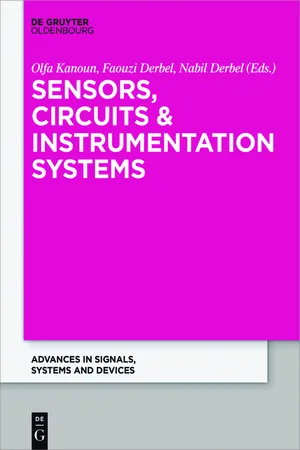
This is a test
- 102 pages
- English
- ePUB (mobile friendly)
- Available on iOS & Android
eBook - ePub
Sensors, Circuits & Instrumentation Systems
Book details
Book preview
Table of contents
Citations
Frequently asked questions
At the moment all of our mobile-responsive ePub books are available to download via the app. Most of our PDFs are also available to download and we're working on making the final remaining ones downloadable now. Learn more here.
Both plans give you full access to the library and all of Perlego’s features. The only differences are the price and subscription period: With the annual plan you’ll save around 30% compared to 12 months on the monthly plan.
We are an online textbook subscription service, where you can get access to an entire online library for less than the price of a single book per month. With over 1 million books across 1000+ topics, we’ve got you covered! Learn more here.
Look out for the read-aloud symbol on your next book to see if you can listen to it. The read-aloud tool reads text aloud for you, highlighting the text as it is being read. You can pause it, speed it up and slow it down. Learn more here.
Yes, you can access Sensors, Circuits & Instrumentation Systems by Olfa Kanoun, Faouzi Derbel, Nabil Derbel in PDF and/or ePUB format, as well as other popular books in Technology & Engineering & Signals & Signal Processing. We have over one million books available in our catalogue for you to explore.
Information
B. Mezghani, F. Tounsi and M. Masmoudi
Static Behavior Analytical and Numerical Analysis of Micromachined Thermal Accelerometers
B. Mezghani, F. Tounsi and M. Masmoudi: University of Sfax, National Engineering School of Sfax (ENIS) Electronics, Micro-technology and Communication (EMC) Research Group, Sfax, Tunisia, e-mails:[email protected]; [email protected]; [email protected].
Abstract: This paper presents static behavior analytical study of micromachined convective accelerometers. This includes both heat conduction and convection behavior study and modeling. A mixed modeling technique has been used to derive general expressions governing heat conduction and convection of MEMS thermal accelerometers. This technique is based on the use of results from FEM simulations to develop an analytical model where all derived expressions are as a function of biasing temperatures and key design geometry parameters. For conduction behavior analysis, two variables are being used in FEM simulations: heater temperature and micromachined cavity depth. The latter parameter has a large impact on the overall conductive behavior of thermal accelerometers since it fixes the volume where the heat bubble can expand. In addition, heater temperature is considered to be the only parameter that fixes heat distribution in the cavity. This modeling has led to the derivation of expressions for both heater heat transfer coefficient and common mode temperature. These physically-based derived expressions govern the overall sensor conductive behavior. Concerning heat convection behavior, cavity width parameter has been added as a third variable. Using simulation data points, fitting technique has been used to develop an analytical expression of differential temperature, proportional to sensitivity, as a function of the above design and temperature parameters. This study helps to predict sensor performance at an early design stage and more importantly for different sensor design geometries and temperatures.
Keywords: Thermal accelerometer, micromachined, analytical model, FEM simulation, spherical model.
Mathematics Subject Classification 2010: 65C05, 62M20, 93E11, 62F15, 86A22
1Introduction
Since the introduction of miniature micromachined components, many new sensors are reported in literature [1–7]. One of these new microscopic electromechanical structures is the inertial sensor which was introduced after the recent progress in the development of semiconductor processing technology. Inertial sensors, as accelerometers, measure accelerations in one, two or three orthogonal axes. Acceleration measurements are typically used to calculate in-plane velocity and position, inclination, tilt or orientation in two or three dimensions with respect to the acceleration of gravity, as well as to measure vibration and impact.
Over the last few years, numerous types of micromachined accelerometers have been designed and developed [6–15]. Due to their integrated nature, they all have the key features of miniature size, compact design, light weight, sensitive to small accelerations, low power consumption and low cost due to the batch fabrication integrated process. Thanks to their numerous advantages, MEMS accelerometers have been widely used in both consumer and military fields. This includes automotive industry, consumer applications as laptops, navigation systems, military industry as in missile guidance and in robotics and system automation. As a natural outcome, research centers are increasingly interested in the development of new, smaller, more sensitive, faster and also more reliable MEMS accelerometers. These needed developments in sensor performance require the development, in the first place, of a fabrication process which is obviously a crucial factor to provide the good stability and the needed high reproducibility as well as having a high yield of the integrated sensor.
Usually, micromachined accelerometers such as capacitive accelerometers [8] and piezoresistive accelerometers [9] measure the applied acceleration by means of using a proof mass. By quantifying the displacement of this proof mass, these types of accelerometers are able to measure the applied acceleration. We have to note here that this operation mode, which is based on the proof mass displacement, constitutes the main disadvantage of these types of sensors. This is mainly due to the possibility of system breakdown under a high signal giving a low shock surv...
Table of contents
- Cover
- Title Page
- Copyright
- Preface of the Volume Editor
- Contents
- Modal Analysis of MEMS Using Ultrasonic Base Excitation
- Decentralized Fault Detection in Wireless Sensor Network based on gaussian function error
- Static Behavior Analytical and Numerical Analysis of Micromachined Thermal Accelerometers
- MEMS-Based Clamped-Clamped Beam Resonator Capacitive Magnetometer
- Range Extension for Single Hop Wireless Sensor Networks with Wake-up Receivers
- A HW/SW Implementation on FPGA of Absolute Robot Localization Using Webcam Data